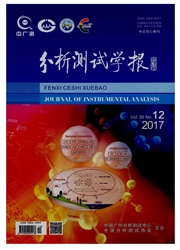

 中文摘要:
中文摘要:
采用电化学发光方法研究了全氟辛酸(Perfluorooctanoic acid,PFOA)对DNA的损伤.结合量子点(Quantum dots,QDs)及纳米金(Nano gold,NG)颗粒的独特性能,制备了量子点-纳米金复合颗粒.将小牛胸腺DNA(ct-DNA)修饰在玻碳电极表面,然后修饰量子点-纳米金复合颗粒,构建了基于纳米金的量子点电化学发光传感器,研究了纳米金对量子点发光强度的增强作用,并利用该传感器进一步研究了PFOA对ct-DNA的损伤作用.采用原子力显微镜(AFM)及X射线光电子能谱(XPS)技术对修饰电极的表面形态进行表征.实验结果表明,与单一的量子点电化学发光传感器相比,纳米金-量子点复合物电化学发光传感器的发光强度增大了近4倍.同时,ct-DNA经PFOA温浴作用后,电化学发光强度发生显著降低,表明PFOA导致了ct-DNA损伤.
 英文摘要:
英文摘要:
In this article, an unique electrochemiluminescence sensor was built to study DNA dam- age due to perfluorooctanoic acid'(PFOA). First of all, combining the special properties of quantum dots(QDs) and nano gold particles( NG), the quantum dots -nano gold( QDs -NG) composite par- ticles was prepared. Then, the calf thymus DNA (ct-DNA) was modified onto the surface of glassy carbon electrode (GCE). After dried in the incubator, the QDs -NG composite particles was dropped onto the electrode. In this way, the electrochemiluminescence sensor based on QDs - NG particles was established. It was used to study the enhancement effect of QDs luminous intensity based on NG particles. And further, the DNA damage due to PFOA was also investigated using the electrochemiluminescence sensor. The atomic force microscope(AFM) and X ray photoelectron spec- troscopy(XPS) were also adopted to characterize the surface morphology of modified electrode. The results showed that the existence of the NG particles had obvious enhancement effect on the luminous intensity of QDs, and the electrochemiluminescence intensity was increased about four times. On the other hand, after the interaction between PFOA and ct-DNA at 37 ℃, electrochemiluminescence in- tensity was decreased to a great degree, which indicated that PFOA caused DNA damage
 同期刊论文项目
同期刊论文项目
 同项目期刊论文
同项目期刊论文
 High-Resolution Hydrodynamic Chromatographic Separation of Large DNA Using Narrow, Bare Open Capilla
High-Resolution Hydrodynamic Chromatographic Separation of Large DNA Using Narrow, Bare Open Capilla 期刊信息
期刊信息
